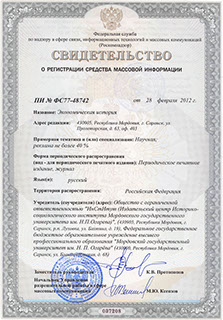Экономическая историЯ
Russian Journal of Economic History
ISSN 2409-630X (Print)
ISSN 2618-916X (Online)
Expert board:
- Scientific Council of RAS on economic history;
- Research and Educational Center «The economic history of Central Russia and the Middle Volga region» of Ogarev Mordovia State University;
- Center of Economic History of Lomonosov Moscow State University
Navigation
Certificate of registration

ISSN 2409-630X (Print), ISSN 2618-916X (Online)
DOI: 10.15507/2409-630X.058.018.202203.233-246
O. V. Koshina 1, L. G. Skvortsova2
1, 2 National Research Ogarev Mordovia State University (Saransk, Russia)
1 e-mail: koshinaolga@rambler.ru
2 e-mail: skvorcovalg@inbox.ru
Socio-Economic Development Village Novie Verkhissy in the 1920s–1930s
Abstract
Introduction. Socio-economic development of one of the villages of Mordovia in the 1920s–1930s emerges the scientific interest, since the development of rural areas remains one of the priorities of the regional policy. The New Economic Policy created conditions for the development of the peasant economy by introducing a tax in kind, allowing free trade and leasing land. The study of collectivization raises questions about the effectiveness of collective forms of management, which does not lose relevance in modern conditions of a variety of forms of ownership and the search for effective ways to develop agriculture.
Materials and Methods. Materials used: archival documents, periodical publications and memoirs of the inhabitants of the village Novye Verkhissy. The methods that have been applied are narrative; the method of deduction combined with the method of induction; idiographic method.
Results. During the famine in 1921–1922 in Novye Verkhissy, as a result of drought and devastation during the Civil War and “military communism”, sown areas decreased, crop yields decreased, and livestock breeding suffered. Famine of 1924–1925 after a drought and crop failure, was overcome by issuing irrevocable grain loans to the population and creating a public plowing and seed fund. In the early 1930s the collective farm “Red Mordovia” was created in the village. Advances in hemp production in the second half of the 1930s brought the collective farm to a leading position in the Insar district. A school, a library, a kindergarten, a People’s House worked in Novye Verkhissy, mail was delivered to the village, local self-government solved the social and cultural problems of the village.
Discussion and Conclusion. Among the problems discussed in the literature of the socio-economic development of the countryside in the 1920s–1930s: the problem of the extent of the famine of 1921–1922 and the famine of 1924–1925; the problem of the effectiveness of the NEP for the development of the countryside; the problem of the damage caused by mass collectivization. Socio-economic development of village Novye Verkhissy in the 1920s–1930s corresponded to the patterns prevailing in Mordovia and in the country during this period. The New Economic Policy allowed the village of Mordovia to recover by 1928. During the years of collectivization, on the one hand, there was a partial mechanization of peasant labor, its productivity increased, the infrastructure of the village developed, and the market for agricultural products expanded. On the other hand, dispossession took place, hard work prevailed in the village, famine in the early 1930s claimed many lives. In the socio-cultural sphere of the village in the 1920s–1930s progress was observed: schools and libraries were built, public self-government was developed.
Keywords: agriculture, peasants, New Economic Policy, collectivization, famine, dispossession, food tax, cultural revolution, village council, self-government.
For citation: Koshina O. V., Skvortsova L. G. Socio-Economic development of village Novie Verkhissy in the 1920s–1930s. Ekonomicheskaya istoriya = Russian Journal of Economic History. 2022; 18(3): 233–246. (In Russ.). DOI: 10.15507/2409-630X.058.018.202203.233-246.
© Ogarev Mordovia State University. History and Sociology Institute, 2017
68, Of. 411, Bolshevistskaya St., 430005, The editorial office of the scholarly journal «Russian Journal of Economic History»
Tel.: (8342) 24-25-90; 27-07-11, Fax: (8342) 24-25-90, E-mail: jurnal-econom-hist@isi.mrsu.ru
Designed by A. Napalkov, Email: napalkov@isi.mrsu.ru

